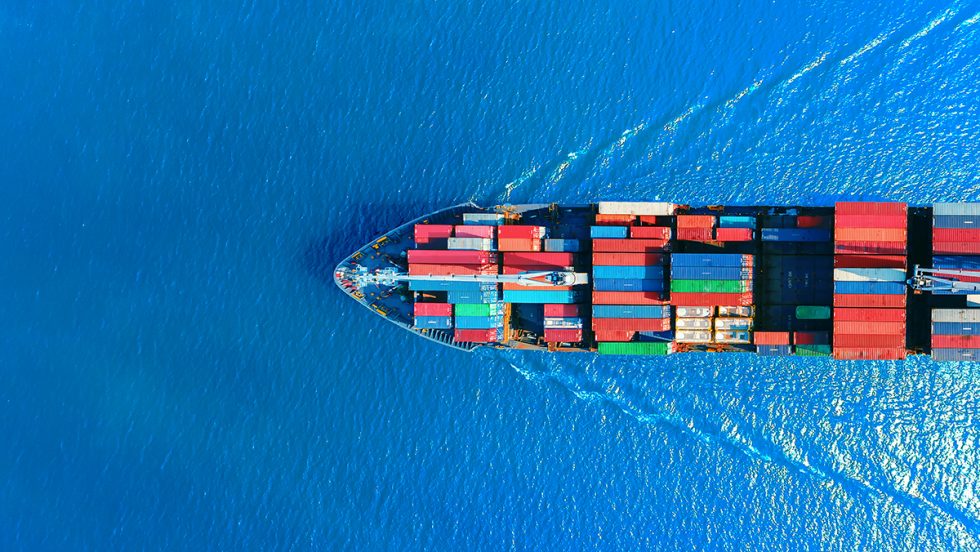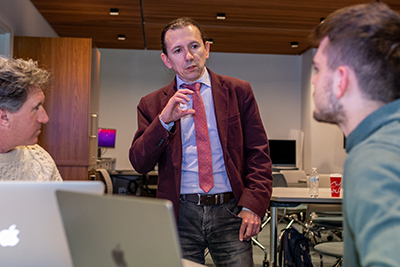
Behind the unsung innovations driving global commerce.

Juan Jaramillo, PhD, associate professor of decision sciences and marketing
If you see fruit or shirts for sale at your local big-box store, there’s a good chance they’ve been imported. Shoppers’ interest in foreign goods is nothing new in the history of global trade, but there is one relatively recent development at play: Many imported goods are now cheaper than the domestic alternatives.
The economic system that enables this improbable competitive advantage is astonishingly complex. But underpinning the international trade of cheap goods is one simple invention: the shipping container. So argues Juan Jaramillo, PhD, associate professor of decision sciences and marketing at Adelphi, who co-edited the essay collection The Container: A Box That Revolutionized the Transport of Goods (Sello Editorial Universidad de Medellín)1 alongside colleagues in his native Colombia. “Without the shipping container, global commerce would not exist at the levels we see today,” he said.
Until the second half of the 20th century, shipping methods and container sizes varied based on national and regional preferences. In those days, if a Chilean exporter wanted to sell apples in America, the container it shipped their produce in would very likely have been either too big or too small for American trucks or trains. As a result, they would have had to pay—and wait—for their shipment to be unloaded at an American dock before being promptly reloaded into an American shipping container. This extra work wouldn’t just make the apples prohibitively expensive; it likely would have led to their spoilage long before reaching shelves.
In 1956, Malcolm McLean, a shipowner, made his business more efficient by standardizing a container for international trade: the intermodal shipping container. “Intermodal transportation makes it possible to move from one transportation mode to another without repacking the contents,” Dr. Jaramillo explained. “Since containers are standard, any container fits in any truck, railroad car or ship. The modularity speeds up the process and lowers the cost of moving goods globally.”
As the advantage of standardization became clear, more exporters around the world adopted intermodal shipping containers until it became difficult to do business without them. Today, the International Organization for Standardization (ISO) has set official specifications for every container in use: “… built with rust-retardant Corten steel, approximately 8 feet 6 inches tall, almost 8 feet wide, and either 20 or 40 feet long,” according to Dr. Jaramillo. “They must have standard casting on their corners so that they can be secured by standard twist locks and fit in any transportation mode.” Because these qualities make it possible to stack containers in columns 10 units high, a single large ship can move more than 8,000 containers at once. With ships capable of moving so much merchandise without the hassle of reloading, the price of imported goods has plummeted.
As Dr. Jaramillo continues to stress the value of international collaboration in his classroom at Adelphi, he is now focusing his attention on what he believes will be the next revolution in international trade: machine learning’s transformation of business analytics. In his forthcoming book—another cross-border project, this time with colleagues at Woxsen University in India—Machine Learning for Business Analytics: Real-Time Data Analysis for Decision-Making (Taylor & Francis, 2022),2 Dr. Jaramillo explores the emerging power of data in shaping business practices. “Machine learning is the application of algorithms with learning capabilities to identify existing patterns in data, which facilitates the decision-making process,” he said. “Businesses are increasingly implementing machine learning applications to take advantage of collected data. Through analytics, they can understand their customers better and create more personalized services. They can also better understand their own personnel, which will allow them to design better career paths.”
Because machine learning is poised to become fully integrated into global business operations, yielding a different economic experience for each person, Dr. Jaramillo ended on a note of caution. “We are reaching the point at which algorithms make business decisions, not people,” he said. “It is crucial that leaders ensure algorithms only make fair decisions. Given the scale of machine learning’s application, any mistake made by an algorithm will have repercussions that affect many people.
1 Ceballos, Silvia, and Erica Guisao, Juan Jaramillo, and Santiago Londoño. El contenedor: una caja que revolucionó el transporte de mercancía. Sello Editorial Universidad de Medellín, 2020
2 Hemachandran K, and Sayantan Khanra, Raul V. Rodriguez, Juan Jaramillo, editors. Machine Learning for Business Analytics: Real-Time Data Analysis for Decision-Making. Taylor & Francis, 2022.